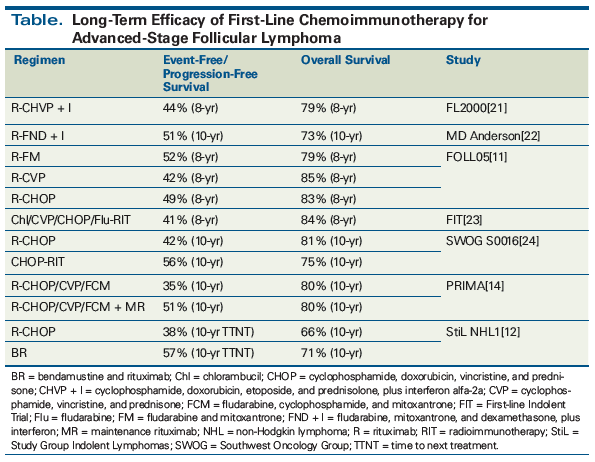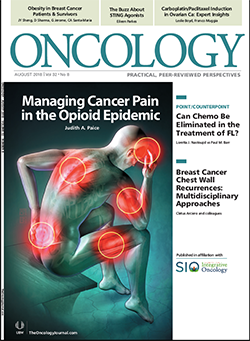COUNTERPOINT: Can Chemotherapy Be Eliminated in the Treatment of Follicular Lymphoma?
It is clear that chemoimmunotherapy has redefined the history of follicular lymphoma, producing survival rates measured in decades.
Oncology (Williston Park). 32(8):404, 407-9.

Paul M. Barr, MD

Table. Long-Term Efficacy of First-Line Chemoimmunotherapy for Advanced-Stage Follicular Lymphoma

No-Chemotherapy Remains an Essential Part of Therapy for Follicular Lymphoma
For asymptomatic patients with follicular lymphoma, observation remains the standard of care.[1] Similarly, single-agent rituximab is reasonable for patients with low-burden symptomatic disease.[2] However, given that most patients have advanced-stage disease at diagnosis and will progress over time, the majority of follicular lymphoma patients ultimately require chemotherapy. Of the 2,728 follicular lymphoma patients enrolled in the National LymphoCare Study, two-thirds had advanced-stage disease and two-thirds had intermediate- or high-risk disease as defined by the Follicular Lymphoma International Prognostic Index.[3] Most were treated with initial systemic combination chemotherapy, while observation and single-agent rituximab were felt to be appropriate for 18% and 14% of patients, respectively.
The reasoning behind these therapeutic choices is straightforward. The course of follicular lymphoma has improved over time, in large part due to treating physicians’ ability to administer combination chemotherapy plus immunotherapy. Specifically, the median overall survival (OS) of patients treated at Stanford University was estimated to be 11 years between 1960–1986 and increased to > 19 years between 1987–2003.[4] While the introduction of anti-CD20 therapy has also clearly contributed to the improved outcomes, these survival gains largely preceded routine use of rituximab. The patients diagnosed between 1987 and 1996 achieved a median OS of 18.6 years, with only 27% of patients receiving rituximab at any point. This time period primarily corresponds with the development of combination chemotherapy and advances in supportive care, such as growth factor use, enabling more effective treatment of advanced-stage, high-risk patients, as well as those developing grade 3 or transformed disease. While these data are derived from a cohort of relatively young patients, these observations are similar to analyses of follicular lymphoma outcomes based on the National Cancer Institute’s Survival, Epidemiology, and End Results Program database.[5]
Prospective clinical trials further support these observational studies. However, chemotherapy together with anti-CD20 antibodies has become the foundation of clinical trials, given the survival benefit achieved with the combination.[6,7] Improved progression-free survival (PFS) rates have been steadily achieved in randomized studies with the use of chemotherapy plus rituximab in the first-line setting.[8-10] Early results from this era showed follicular lymphoma patients to be achieving response rates of > 90%, median PFS durations of 6 to 7 years, and 5-year OS rates approaching 90%. With long-term follow-up, roughly one-third to one-half of patients are alive and without lymphoma progression at 10 years (Table). Additionally, OS rates in the 70% to 80% range demonstrate the tolerability of contemporary chemoimmunotherapy, with the ability to re-treat patients later if necessary.
Several lessons have been learned from these studies, allowing physicians to administer treatment regimens that provide disease control while minimizing toxicity. While more immunosuppressive therapies provide excellent disease control, late adverse effects may reduce survival rates over the long term. In the FOLL05 study, higher rates of secondary malignancies were noted following anthracycline- or fludarabine-based therapy, as compared with R-CVP (rituximab plus cyclophosphamide, vincristine, and prednisone).[11] Fewer long-term data are available for bendamustine plus rituximab, but OS appears similar, with better tolerability compared with R-CHOP (rituximab plus cyclophosphamide, doxorubicin, vincristine, and prednisone).[12] Though designed to prolong remissions, consolidative and maintenance strategies have raised somewhat similar concerns. The 10-year follow-up of the Southwest Oncology Group S0016 trial showed that R-CHOP plus radioimmunotherapy provided a higher PFS rate of 56% compared with 42% for R-CHOP alone. However, this translated into a numerically lower OS rate of 75% compared with 81% with R-CHOP alone, due in part to the higher incidence of death related to myelodysplastic syndrome or acute myeloid leukemia in the radioimmunotherapy arm.[13]
Maintenance anti-CD20 therapy can clearly improve PFS rates but may have varying effects following different induction regimens. The PRIMA study demonstrated an improved PFS rate with 2 years of maintenance rituximab, predominantly following R-CHOP.[14] While a similar benefit has yet to be demonstrated following bendamustine plus rituximab, retrospective analyses suggest some degree of improved disease control. However, a higher rate of fatal events, primarily during maintenance administration, was noted following bendamustine in the GALLIUM study.[15] The lack of a clear OS benefit and toxicity concerns in some settings have therefore limited widespread adoption of maintenance therapy.
Multiple clinical investigators are focused on developing less toxic combinations using agents with novel targets. However, severe side effects have been observed with several “chemo-free” regimens.[16-18] While few have demonstrated adequate risk/benefit ratios to warrant upfront testing, lenalidomide plus rituximab has demonstrated promise. Phase II study results in previously untreated patients yielded 5-year PFS and OS rates of 70% and 100%, respectively.[19] Given these outcomes, the phase III RELEVANCE trial was conducted to compare lenalidomide plus rituximab vs chemoimmunotherapy, with more than 70% of patients receiving R-CHOP induction in the chemoimmunotherapy arm. No difference in overall response rate, complete remission rate, or PFS was observed. Despite differences in the toxicity profiles, roughly 30% of patients in each arm discontinued therapy early.[20]
Based on these data, chemotherapy remains standard of care in the treatment of follicular lymphoma. Long-term reports have led some to speculate that a proportion of patients are cured with chemoimmunotherapy. Given the indolent natural history of follicular lymphoma and the continued downward slope of the survival curves, it is premature to draw this conclusion. Nonetheless, it is clear that chemoimmunotherapy has redefined the history of the disease, producing survival rates measured in decades. The next steps forward will involve investigations focused on a precision medicine approach. It is only through risk-adapted and molecularly directed therapy that we will further refine treatment paradigms and move closer to a cure for follicular lymphoma.
Financial Disclosure:Dr. Barr has been a consultant for Celgene and Genentech.
References:
1. Advani R, Rosenberg SA, Horning SJ. Stage I and II follicular non-Hodgkin’s lymphoma: long-term follow-up of no initial therapy. J Clin Oncol. 2004;22:1454-9.
2. Martinelli G, Schmitz SF, Utiger U, et al. Long-term follow-up of patients with follicular lymphoma receiving single-agent rituximab at two different schedules in trial SAKK 35/98. J Clin Oncol. 2010;28:4480-4.
3. Friedberg JW, Taylor MD, Cerhan JR, et al. Follicular lymphoma in the United States: first report of the National LymphoCare Study. J Clin Oncol. 2009;27:1202-8.
4. Tan D, Horning SJ, Hoppe RT, et al. Improvements in observed and relative survival in follicular grade 1-2 lymphoma during 4 decades: the Stanford University experience. Blood. 2013;122:981-7.
5. Swenson WT, Wooldridge JE, Lynch CF, et al. Improved survival of follicular lymphoma patients in the United States. J Clin Oncol. 2005;23:5019-26.
6. Fisher RI, LeBlanc M, Press OW, et al. New treatment options have changed the survival of patients with follicular lymphoma. J Clin Oncol. 2005;23:8447-52.
7. Liu Q, Fayad L, Cabanillas F, et al. Improvement of overall and failure-free survival in stage IV follicular lymphoma: 25 years of treatment experience at the University of Texas MD Anderson Cancer Center. J Clin Oncol. 2006;24:1582-9.
8. Hiddemann W, Kneba M, Dreyling M, et al. Frontline therapy with rituximab added to the combination of cyclophosphamide, doxorubicin, vincristine, and prednisone (CHOP) significantly improves the outcome for patients with advanced-stage follicular lymphoma compared with therapy with CHOP alone: results of a prospective randomized study of the German Low-Grade Lymphoma Study Group. Blood. 2005;106:3725-32.
9. Marcus R, Imrie K, Solal-Celigny P, et al. Phase III study of R-CVP compared with cyclophosphamide, vincristine, and prednisone alone in patients with previously untreated advanced follicular lymphoma. J Clin Oncol. 2008;26:4579-86.
10. Salles G, Mounier N, de Guibert S, et al. Rituximab combined with chemotherapy and interferon in follicular lymphoma patients: results of the GELA-GOELAMS FL2000 study. Blood. 2008;112:4824-31.
11. Luminari S, Ferrari A, Manni M, et al. Long-term results of the FOLL05 trial comparing R-CVP versus R-CHOP versus R-FM for the initial treatment of patients with advanced-stage symptomatic follicular lymphoma. J Clin Oncol. 2017;36:689-96.
12. Rummel MJ, Maschmeyer G, Ganser A, et al. Bendamustine plus rituximab (B-R) versus CHOP plus rituximab (CHOP-R) as first-line treatment in patients with indolent lymphomas: nine-year updated results from the StiL NHL1 study. J Clin Oncol. 2017;35(suppl):abstr 7501.
13. Shadman M, Li H, Rimsza L, et al. Continued excellent outcomes in previously untreated patients with follicular lymphoma after treatment with CHOP plus rituximab or CHOP plus 131I-tositumomab: long-term follow-up of phase III randomized study SWOG-S0016. J Clin Oncol. 2018;36:697-703.
14. Salles GA, Seymour JF, Feugier P, et al. Long-term follow-up of the PRIMA study: half of patients receiving rituximab maintenance remain progression free at 10 years. Blood. 2017;130:abstr 486.
15. Marcus R, Davies A, Ando K, et al. Obinutuzumab for the first-line treatment of follicular lymphoma. N Engl J Med. 2017;377:1331-44.
16. Barr PM, Saylors GB, Spurgeon SE, et al. Phase 2 study of idelalisib and entospletinib: pneumonitis limits combination therapy in relapsed refractory CLL and NHL. Blood. 2016;127:2411-5.
17. Smith SM, Pitcher BN, Jung SH, et al. Safety and tolerability of idelalisib, lenalidomide, and rituximab in relapsed and refractory lymphoma: Alliance A051201 and A051202 phase I trials. Lancet Haematol. 2017;4:e176-e182.
18. Ujjani CS, Jung SH, Pitcher B, et al. Phase 1 trial of rituximab, lenalidomide, and ibrutinib in previously untreated follicular lymphoma: Alliance A051103. Blood. 2016;128:2510-6.
19. Martin P, Jung SH, Pitcher B, et al. A phase II trial of lenalidomide plus rituximab in previously untreated follicular non-Hodgkin’s lymphoma (NHL): CALGB 50803 (Alliance). Ann Oncol. 2017;28:2806-12.
20. Fowler N, Morschhauser F, Feugier P, et al. RELEVANCE: phase III randomized study of lenalidomide plus rituximab (R2) versus chemotherapy plus rituximab, followed by rituximab maintenance, in patients with previously untreated follicular lymphoma. J Clin Oncol. 2018;36(suppl):abstr 7500.
21. Bachy E, Houot R, Morschhauser F, et al. Long-term follow up of the FL2000 study comparing CHVP-interferon to CHVP-interferon plus rituximab in follicular lymphoma. Haematologica. 2013;98:1107-14.
22. Nastoupil LJ, McLaughlin P, Feng L, et al. High ten-year remission rates following rituximab, fludarabine, mitoxantrone and dexamethasone (R-FND) with interferon maintenance in indolent lymphoma: results of a randomized study. Br J Haematol. 2017;177:263-70.
23. Morschhauser F, Radford J, Hoof AV, et al. 90Yttrium-ibritumomab tiuxetan consolidation of first remission in advanced-stage follicular non-Hodgkin lymphoma: updated results after a median follow-up of 7.3 years from the international, randomized, phase III first-line indolent trial. J Clin Oncol. 2013;31:1977-83.
24. Shadman M, Li H, Rimsza L, et al. Continued excellent outcomes in previously untreated follicular lymphoma patients after treatment with CHOP plus rituximab or CHOP plus (131) iodine-tositumomab-long term follow-up of phase III randomized study SWOG S0016. Blood. 2016;128:abstr 616.

Newsletter
Stay up to date on recent advances in the multidisciplinary approach to cancer.
Highlighting Insights From the Marginal Zone Lymphoma Workshop
Clinicians outline the significance of the MZL Workshop, where a gathering of international experts in the field discussed updates in the disease state.